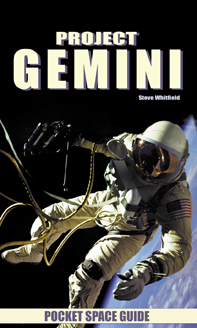 Project Gemini ISBN 9781894959544 $11.95 Canadian |
Project Gemini “. . . we wanted to see how man could last for two weeks in space before we committed to go to the Moon . . .” In 1962 President Kennedy proclaimed that America was going to the Moon. All that was left for the scientists, engineers and managers to do was figure out how – and then be right the first time, every time. Project Mercury had been a successful start, but it was basically a “man in a can” program – get into orbit, look around, and come back. Only with Project Gemini did America begin to undertake space “missions,” where the astronauts performed experiments and underwent extensive physical testing. “. . . suddenly the engine stops and you go from 8 g's to zero* . . .” In Project Gemini NASA accomplished many American “firsts,” including: “. . . without Gemini, I don't think that Apollo would have been the success that it was* . . .” The Project Gemini Pocket Space Guide provides the essential facts as obtained from official NASA documents, complete with color photographs. Living and working in orbit, remaining in space for days and weeks at a time, the astronauts of Project Gemini gained the experience and knowledge that eventually led to landing on the Moon. Presented chronologically in an easy-to-follow format, this is a book that both seasoned space buffs and aspiring amateurs will find an interesting and informative resource. "Whitfield can draw on clear objectives and well documented achievements for his pair of books. He does this for a remarkably fine result." Universe Today "An attractive value-for-money package." satellite-evolution.com 96 pages; 48 pages of full color photographs. * Gemini Astronaut James A. Lovell (Captain, USN, Ret.)
|
AMAZON.COM
Chapters
Barnes & Noble